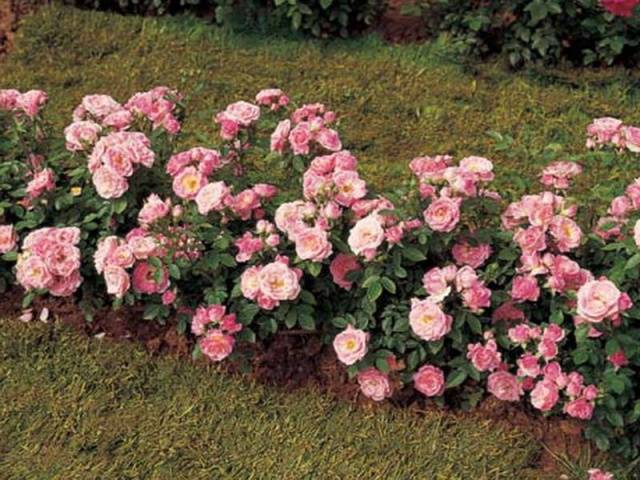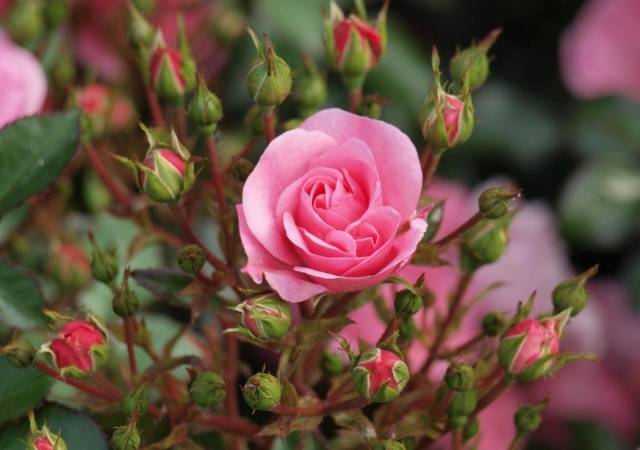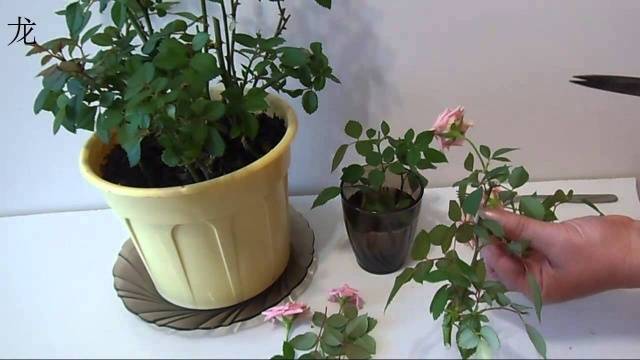Content
Some gardeners do not dare to plant roses on their site, fearing the difficulties of caring for a capricious beauty. But some varieties of roses are undemanding, do not require shelter for the winter, caring for them is simple and accessible to everyone.
Description
Polyanthus roses bloom profusely all summer, and part of autumn before frost. Rose bushes are abundantly covered with small bright flowers.
The main advantages of polyanthus roses:
- High decorativeness of bushes;
- Long bloom;
- Frost resistance;
- Lack of thorns;
- Good immunity;
- Undemanding to the composition of the soil;
- Shade tolerance.
The bushes are used for the decoration of borders, rabatok. Can be used as a houseplant, grown in pots and containers.
Characteristic
The bush is low, up to 50 cm in height, strongly branched. The flowers are simple or double, small in size, up to 4 cm in diameter. Most often red or pink, less often white. They are odorless. The flowers are collected in large inflorescences, one brush can contain up to 50 buds.
The leaves are small, with ciliated stipules, glossy, dark green.
In the rainy, cool season, flowers can get sick with powdery mildew.
Landing
Polyanthus roses will grow and bloom in any conditions, but in order to get a bright abundant flowering of the bushes, as in the photo, you need to know the rules of planting and care.
Bushes of polyanthus roses are not afraid of high acidity of the soil, but these flowers develop best on loose, well-fertilized soil with neutral acidity.
The best place to plant polyanthus rose bushes is sunny and well-ventilated. These roses grow well in partial shade, but the branches of the bushes can stretch and sag under the weight of flowering brushes. In this case, it is necessary to make supports for the bushes.
The size of the planting hole is determined based on the size of the root flower system. The roots of the bushes should be located in it freely, you cannot fold and bend them.
Before planting the bushes, they bring into the planting hole:
- Ripe humus;
- A glass of wood ash;
- Complex of microelements;
- Sand.
Humus must be checked for fungal spores. If a white bloom is noticeable on some parts of the substrate, such humus must be dried well in the sun before use, only then it can be used as a fertilizer for growing flowers.
Complex fertilizers, especially nitrogen fertilizers, must be applied strictly according to the instructions. Excess nitrogen in the soil can harm flowers. It is advisable to choose fertilizers marked "for roses".
Sand is applied only to heavy, clayey soils. The amount of sand is determined depending on the density of the soil. Sandy soils do not require application.
The basic rule is that the size of the aboveground part of the flowers should be equal to the underground one.
After planting flowers, you need to monitor the moisture content of the soil, avoiding drying out and waterlogging. If there is a threat of night frost, the bushes of polyanthus roses must be covered.
Care
Caring for bushes of polyanthus roses is not difficult, often for the full development of roses, timely watering and pruning is enough. In some cases, the bushes of these flowers may need treatment for insects and fungal infections. How to use insecticides and fungicides correctly is indicated in the instructions.
Bushes of polyanthus roses easily tolerate even prolonged waterlogging of the soil, but this can affect flowering. Therefore, watering the bushes is carried out only when the soil is well dried. Usually, watering once a week is enough for rose bushes.
It is advisable to prune bushes several times, the first time it is carried out in early spring, when the first leaves begin to appear on the flowers.
In spring, branches damaged by frost and remnants of old leaves should be removed from the bushes. No more than three trunks are left on the bush, they must be shortened by a third. Branches growing inside the bush are also removed.
During the growing season, you can form a bush to get a more decorative flower. If the tip is removed from the green branch, it will begin to release new branches. A flowering brush will appear at the end of each of these processes by mid-summer.
Bushes of polyanthus roses rarely get sick, but in cool rainy weather, spores of pathogenic fungi begin to actively multiply. If you have recently pruned the bushes, fungi can get into the flower through a fresh cut. To avoid infection, pruning of bushes should be done only in dry weather.
Pest insects rarely cause serious damage to polyanthus rose bushes. Since the flowers of this rose have no scent, most flying insects do not notice it. Of the sucking insects, most often the bushes are annoyed by aphids. Aphid treatment is carried out in dry, calm weather. A solution of the aphid drug is prepared following the instructions. Usually 2 - 3 color treatments are required per season.
Reproduction
Polyanthus roses reproduce very easily. Cuttings of these flowers take root easily; with good care, there is practically no lunge. In addition to cuttings, seedlings of polyanthus roses can be obtained from seeds.
Cuttings
For cuttings, healthy green shoots are chosen for flowers, up to 15 cm in size. They are cut with a very sharp knife so that the cut is even, without protruding fibers. Before planting, rose cuttings can be soaked in a stimulant solution according to the instructions.
Cuttings are placed in a container with a damp, clean substrate to reduce evaporation of water, covered with a lid or plastic bag. The following substrates can be used to germinate flower cuttings:
- Peat;
- Coir;
- Perlite;
- Sawdust;
- Sand.
Peat absorbs water well, but dries out very quickly, it is necessary to constantly monitor the moisture content of the soil. Cuttings can die even after a short drying of the substrate. May contain fungal spores and microorganisms harmful to cuttings.
Coconut fibers work well for growing a rose from cuttings. Cuttings growing in peat are rarely affected by mold or rot.
Perlite absorbs well and releases water when cuttings need it. With its help, it is easy to provide cuttings of polyanthus roses with the necessary moisture. Free from harmful microorganisms.
Wet sawdust can only be used to germinate flower cuttings with treated fungicides. They can contain microflora harmful to flowers in large quantities. It is required to carefully monitor the uniform moisture.
Sand is the least suitable for growing cuttings. It is easily compressed, it is easy to overmoisten. The resulting root system of flowers will experience oxygen starvation. It is advisable to heat the sand to get rid of pathogenic microorganisms.
When the first roots appear, flower seedlings transplanted... For further cultivation, roses will need bright sunlight, a lot of nutrients.
You can plant flowers in a temporary bed, the so-called school, or grow flowers before planting in a permanent place in containers. The basic rule is that young roses can be harmed by direct sunlight and overdrying.
In hot weather, the temperature under the plastic wrap can be too high, so agrofibre is the best choice. Seedlings of these flowers are planted in a permanent place the next year.
Growing from seeds
When growing a rose from seeds, it must be borne in mind that not all seedlings inherit maternal characteristics. Some flowers will not look at all like the rose from which the seeds were taken.
The seeds of most varieties of polyanthus roses require mandatory stratification, except for the Chinese rose "Angel Wings", another name is the angelic rose. Its seeds germinate well and quickly, the seedlings begin to bloom a few months after sowing the seeds.
The seeds of polyanthus roses are treated with disinfectants, dried, then soaked in a stimulant solution. They are planted in clean soil, wrapped in a plastic bag and placed in a cold place for 2 - 3 months. The seeds of these flowers need freezing temperatures to activate growth, so they can be buried in the garden along with the container. If seed roses are grown at home, you can place the container in the freezer.
In the spring, the container is taken out, transferred to a warm, bright place. After 2 - 3 weeks, the first shoots of flowers appear. After their appearance, the plastic film is removed, the first 3 days it is necessary to spray the flower seedlings 2 - 3 times a day.
Flower seedlings are planted in a permanent place when the threat of frost has passed.
Conclusion
Growing polyanthus roses is not burdensome, but they can be used to decorate any corner of the site. These beautiful flowers will gratefully take care and care, rewarding with wonderful, long-lasting flowering.















